Environmental Portraits of Tropical Birds

ARTICLES
ENVIRONM'TAL
PORTRAITS
By Laura L Fellows
Nature Photographer Magazine - Winter 2007
During the many years I spent making portraits of people, I always felt the importance of including the subject's surrounding environment in the image. People are an integral part of the environment in which they live, and their environment, in turn, is an important part of who they are. When I portray people, the surrounding environment adds context to my images and is an essential element in telling the story and conveying what I feel. Environmental portraiture has always been an important expression of my photography. It's a style commonly seen in photography of people but rarely have I seen it applied to photography of birds.
Much photography of birds seems intended to portray the beauty of birds as photographic pieces of art. This style emphasizes the beautiful displays of courting birds such as egrets and herons against simplified backdrops such as water or sky. Another common theme is capturing the appearance of birds in the sharpest possible detail, often as close-ups, in tightly cropped images or in a way that eliminates or blurs the background and surrounding environment. The resulting images are beautiful to behold and pleasing to the eye, but they have the common theme of leaving the surrounding environment out of each image.
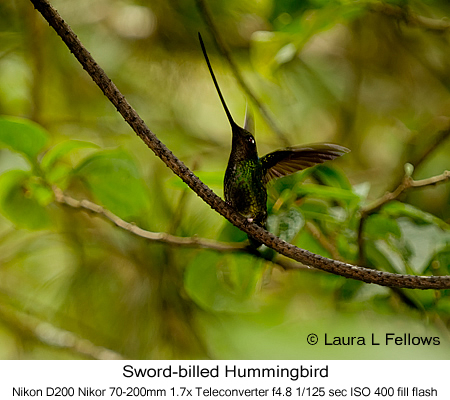
Environmental portraiture of birds portrays a subject as part of its natural setting. There is an artistry to the way a bird fits into its environment that cannot be conveyed if the context is muted, blurred, or left out of the image. Incorporating the setting into an image contributes to the story about the subject and draws the viewer into the place where the image was made. It helps the viewer better appreciate birds as living beings with personalities and lives that transcend their role as artistic subject matter. My vision is to capture their essence in an artful way while giving the viewer a sense of the exotic environments in which they live.
When my partner and I first began traveling in the tropics, it was primarily to satisfy his avid interest in bird watching. I was immediately struck by a strong desire to portray the birds we were seeing through my photography and began the process of learning how to capture satisfying images under often difficult conditions.
After our first visit to the tropics, I fully appreciated the benefits of leaving my Nikon F6 behind and embracing digital technology. I was soon equipped with the latest Nikon digital equipment, a Nikon D200 body, 70-200 mm VR zoom lens, 1.7X teleconverter, SB-800 flash, Better Beamer, Quantum Turbo battery pack, memory cards, and lots of offline digital storage. I also carry a light-weight tripod, which has sometimes had its uses, but that turned out to be impractical much of the time we've been in the field. A tripod doesn't work well in thick forest underbrush and is more a hindrance than a help when trying to capture a bird that presents itself for fleeting moments before flying off or disappearing into the forest. I've been able to dispense with it primarily because my vibration-reduction telephoto lens allows me to shoot at 2-3 shutter speeds slower than would otherwise be practical.
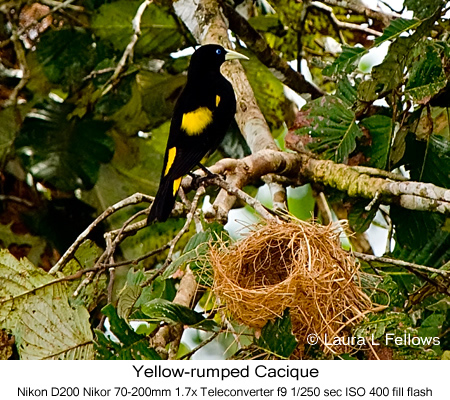
With my new equipment in hand, I was soon back in the tropics seeking opportunities to make environmental portraits of birds. My vision was to capture images not just of the birds themselves but also the world around them. To that end, we have walked numerous rainforest trails, were paddled by our guides through backwater channels of the Amazon headwaters in dugout canoes, and tromped up and down often steep and sometimes muddy trails at many different elevations through montane cloud forests and open paramo in Central and South America.
The easiest way to photograph tropical birds is to wait on a lodge veranda for birds to come to nearby feeders. Many lodges put out feeders that draw hummingbirds to them. Hummingbirds are consummate representatives of the bird diversity found in the tropics, and they offer endless opportunities for making beautiful photographs. My goal has been to capture them in a more natural setting than a lodge veranda would at first glance seem to present. Hummingbirds often stage themselves on a favorite perch in gardens or foliage nearby, a perch they often return to on a regular basis when not at the feeders themselves. This behavior allows a photographer to capture hummingbird images in an environmental setting. My portrait of a Sword-billed Hummingbird taken in the eastern Andes is an excellent example. This male has his bill and wings raised in a threatening posture as he guards his perch. The spread of his wings brings him alive to the viewer, while the sweep of his long bill paralleling the contour of his perch and nearby foliage adds artistry and harmony to the image in a way that draws the viewer into the setting.
Some places in the tropics offer strategically located blinds or towers that provide vantage points for capturing images that would be difficult to obtain in another way. In such places a longer lens is nice but not indispensable. My image of a Yellow-rumped Cacique was taken from an observation tower at Napo Wildlife Center in Ecuador. Caciques and their close relatives, oropendolas, typically nest in colonies high in isolated treetops. This photograph was taken some distance from the nesting tree but puts the viewer into the colony at eye level. It portrays a territorial male guarding his partially constructed nest. Little does the viewer realize the photographer's secret, that the seeming serenity of this scene is illusory and the bird is actually perched in the midst of a raucous cacophony of birds coming and going from the colony tree.
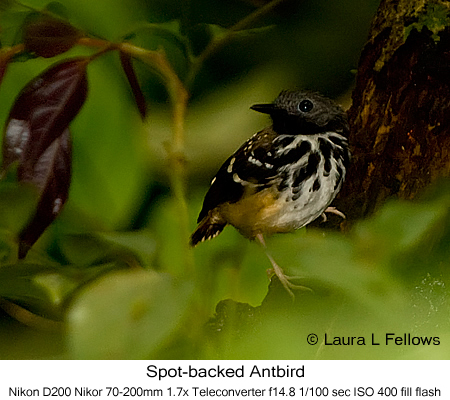
The vast majority of tropical birds do not visit feeders and do not conveniently appear anywhere near the few available blinds. Making environmental portraits of such birds poses a series of special challenges for a photographer, but the possibilities are endless.
The first challenge is to find the birds. This is especially true in the tropics. Rainforests are not the easiest places to spot birds. High forest canopies, middle layers of shorter trees, and often dense underbrush offer many places for birds to hide. The bewildering array of songs and calls one hears in a rainforest are often non-directional, making it difficult to locate a bird that is singing or calling. When a bird is finally spotted, it may be for only a brief moment, it may be facing the wrong way, or it may be partially obstructed by intervening vegetation.
To overcome this challenge, a master guide who is expert at finding and identifying birds is essential. With the help of a guide, photographing even the most secretive birds becomes possible. My image of a Spot-backed Antbird is an excellent case in point. Antbirds lurk furtively in the undergrowth of tropical rainforests and are typically difficult to see or photograph. I captured this image of an especially secretive species in the lowlands of eastern Ecuador near the Rio Napo, a major river that joins with the Rio Negro much farther downstream in Brazil to form the Amazon River. As we walked a trail through the rainforest, I had no idea this bird was present until our guide suddenly led me quietly off the trail and carefully through the underbrush to a suitable opening in the dense foliage. Our guide could hear sounds I could not hear, and he could predict the movements of a bird I could not see. He knew where I should stand, and he pointed out the bird when it appeared.
This moment highlighted a second challenge in making photographs of tropical birds, namely the difficult and variable lighting conditions found within a rainforest. In any given location lighting in forest openings or canopy is very different from lighting in the understory and deep underbrush. I knew the camera's light meter was often inaccurate under these conditions, so I regularly took test shots and checked exposure histograms as we walked through the forest. When our guide led me stealthily off the trail, I couldn't take test shots then because the shutter noise would scare off the bird. My earlier preparation, along with the guide telling me in advance precisely where the bird would appear, allowed me to properly set my exposure and pre-focus on the right spot. When the antbird flitted cautiously into the open, I was ready. The result is an intimate portrait of a quite secretive and infrequently seen bird emerging from its hidden world.
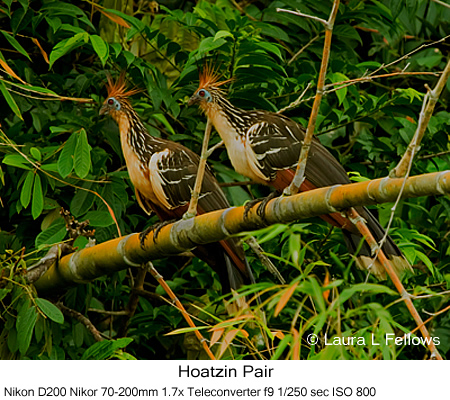
A third challenge I've encountered is that some tropical birds just don't seem willing to be photographed, often because they have been hunted by indigenous people or disturbed too much by previous visitors. One such bird is the Hoatzin, a strange and awkward bird found only in the Amazon Basin. Hoatzins are distant relatives of cuckoos but are so different that biologists place them in a family of birds all their own. We saw numerous Hoatzins as we glided in dugout canoes along tributaries of the Rio Napo. However, the birds we saw nearly always seemed to fly just before I released the shutter or lurked in deep shadows partially obscured by foliage where they were difficult to photograph. On one occasion we spotted a pair perched on a limb protruding out from the bank of a small black-water river. The resulting image captures a male and female, joined together in a life-long pair bond, acting in concert to express alertness and wariness at our presence. The surrounding foliage lures the viewer into their world and adds to the exotic quality of these mysterious birds.
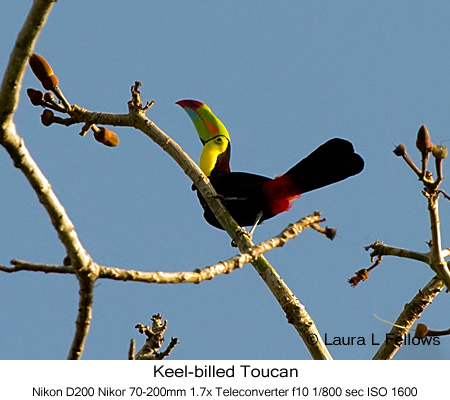
To me, toucans symbolize the tropics. Their loud calls reverberate across mountain valleys and carry great distances through tropical forests. Their extraordinary bills and colorful plumage draw a person to them and inspire the photographer to make images of them. My image of a Keel-billed Toucan taken in Panama captures the way I feel about these extraordinary birds. This male's posture perfectly displays his oversized rainbow-colored bill, yellow face, and scarlet undertail coverts. The surrounding branches perfectly frame the bird's display. The buds on the limbs announce that it is spring-time and dry season in the tropics. The blue sky is a perfect backdrop complementing the colors of the displaying male. All elements come together to make this one of my favorite environmental portraits from the tropics.



